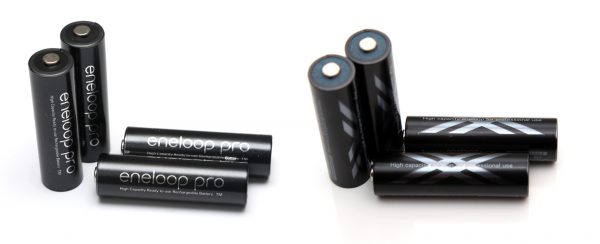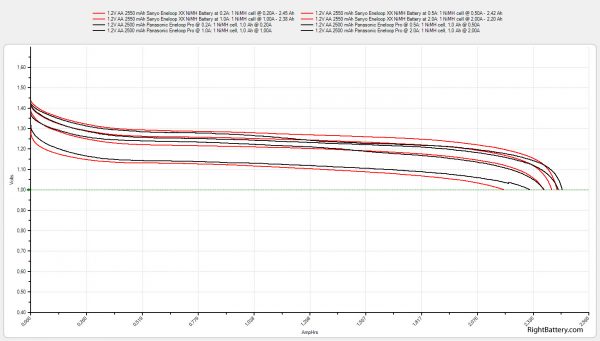RightBattery.com
Tests and reviews of different batteries to help you find the Right One…
Search
Posts Tagged ‘3rd gen vs 5th gen Eneloop’

Time for another Eneloop battery comparison between different generations, namely the latest 5th generation Panasonic Eneloop Pro AA size NiMH batteries rated at 2500 mAh minimum capacity that we have just recently tested and the older 3rd gen 2550 mAh Sanyo Eneloop XX NiMH AA batteries that we have tested a couple of years ago. Specifications wise and performance wise both the older generation and the latest generation high-end Eneloop Pro/XX batteries do seem very similar to each other (like their smaller AAA version), but let us take a closer look at the results we got in our tests…

It seems that the newer Panasonic Eneloop Pro batteries manage to perform slightly better in terms of usable capacity in all of our tests at constant current loads of 0.2A, 0.5A, 1.0A and 2.0A, though the difference isn’t that big if you take a closer look at the numbers. It seems that the newer generation might be handling a bit better higher currents as the performance at 2.0A seems to be the only one with more significant difference between the 3rd generation Eneloop XX and the latest 5th generation Eneloop Pro AA NiMH batteries we have tested. Still, the good news is that the newer Panasonic Eneloop Pro batteries do manage to keep up with the expected good performance we are used to wit the Eneloop brand of rechargable batteries.
mAh Capacity – Eneloop XX – Eneloop Pro
— 0.2A load – 2452 mAh – 2472 mAh
— 0.5A load – 2423 mAh – 2453 mAh
— 1.0A load – 2385 mAh – 2388 mAh
— 2.0A load – 2200 mAh – 2322 mAh
Wh Capacity – Eneloop XX – Eneloop Pro
— 0.2A load – 3.096 Wh – 3.080 Wh
— 0.5A load – 2.999 Wh – 3.015 Wh
— 1.0A load – 2.856 Wh – 2.870 Wh
— 2.0A load – 2.436 Wh – 2.601 Wh

Back in 2013 we have tested the last generation of Sanyo Eneloop XX AAA NiMH batteries, right before they changed from Sanyo to Panasonic and since we have just managed to test the latest generation of Panasonic Eneloop Pro AAA NiMH batteries we have decided to see how much has changed in 5 years time and if the change is actually for the better or not. New generations should mean improvements in features and performance and when you give it 5 years of time, then you should expect some change, right?

The Sanyo Eneloop XX (HR-4UWXB) we tested back in 2013 were a third generation XX / PRO series of Eneloop rated at 950 mAh with minimum capacity of 900 mAh with 500 recharge cycles and 85% capacity retained in a year. Fast forward to Panasonic Eneloop PRO (BK-4HCDE) which are the latest fifth generation Eneloop Pro batteries we have 930 mAh minimum capacity and 930 mAh rating with 500 recharge cycles and 85% capacity left after 1 year. It seems nothing that much has changed in terms of base specifications for the the XX / PRO NiMH AAA size Eneloop batteries, but let us see how are things in our tests 5 years apart and two generations difference.
mAh Capacity – Eneloop XX – Eneloop Pro
— 0.1A load – 925 mAh – 903 mAh
— 0.2A load – 856 mAh – 901 mAh
— 0.5A load – 827 mAh – 888 mAh
— 1.0A load – 689 mAh – 634 mAh
Wh Capacity – Eneloop XX – Eneloop Pro
— 0.1A load – 1.153 Wh – 1.131 Wh
— 0.2A load – 1.047 Wh – 1.103 Wh
— 0.5A load – 0.954 Wh – 1.051 Wh
— 1.0A load – 0.733 Wh – 0.658 Wh
The test results show that the newer Eneloop PRO AAA bateries have a little less usable capacity at the lowest 0.1A load current, but manage to perform better in general in lower to medium current loads. The performance of the 5th generation Pro batteries under 0.1A, 0.2A and 0.5A is closer and more consistent, however at the higher 1.0A load the newer Pro is behind what the earlier 3rd gen Eneloop XX batteries managed to provide. In general not that much difference between the two and Eneloop XX / Pro AAA NiMH batteries still remain very good performer apparently. It is however interesting to note that capacity wise not much has changed in 5 years time for the AAA cells here, there are still no 1000 mAh models or higher for example, so are we reaching a limit for the capacity of the low self discharge NiMHs? Guess we’ll see soon enough after checking some of the other newer Eneloop models and compare them to the older generations that we have tested a while ago…